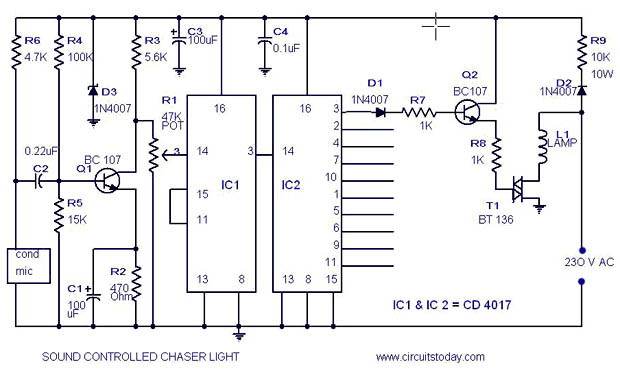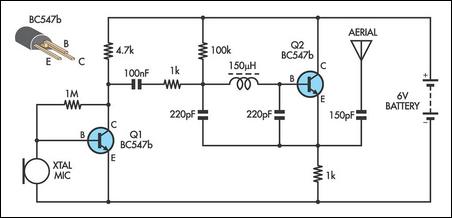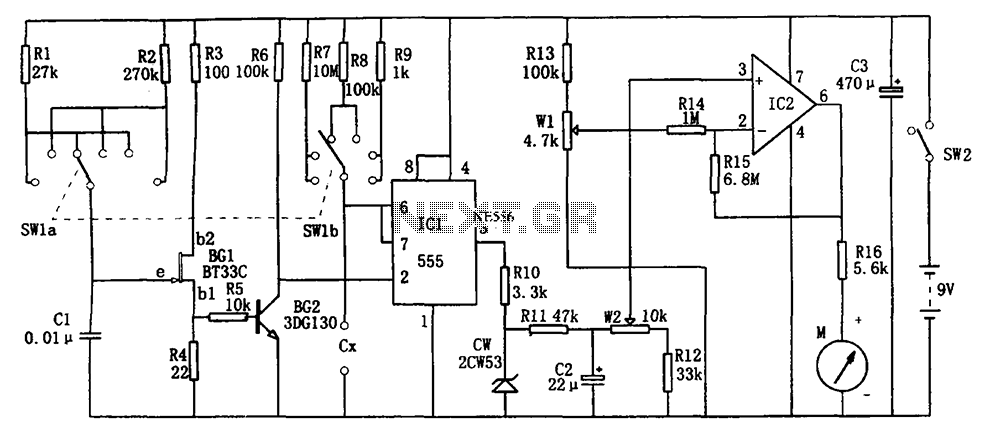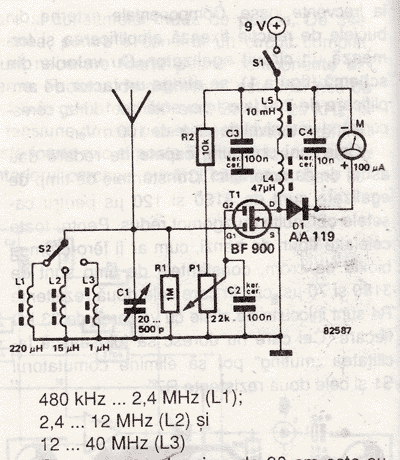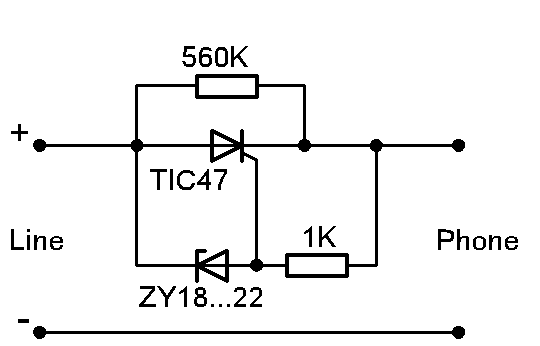
Capacitor Box Circuit

This is the discharging circuit. The red lines indicate the flow of energy from the capacitors to the terminals when the switch is in the upward position. The circuit is complete due to the connection of the terminals by Ni-Chrome wire or solder. The green section of the circuit represents the safety feature: when the relay is turned off or the relay switch is opened (such as when the box is opened), the K1 switch closes, allowing the capacitors to release all of their energy into the resistor R1. This discharge occurs within milliseconds. The schematic displays four capacitors arranged in parallel, each with a capacitance of 4 µF, resulting in a total capacitance of 16 µF. To the right, a voltage divider and voltmeter are present. The voltmeter measures the voltage across the capacitors, which can reach up to 3500 V. Therefore, a voltage divider with a factor of 1/100 is used; a reading of 35 V on the voltmeter corresponds to 3500 V across the capacitors. This setup enables monitoring of the capacitor charge status and facilitates safe discharging when necessary, such as before manipulating the probe or ensuring the box is fully discharged during storage. A three-way switch is located to the right, allowing control over the charging and discharging of the capacitors. When the switch is in the downward position, the capacitors are charged by a power supply located at the bottom right of the circuit, which transforms 9 V into 4000 V. The power supply, E1, is set to 9 V and situated outside the box, allowing manipulation of only the 9 V wires externally while high voltage remains contained within the box during charging. The middle position of the switch places the system in an idle state, providing time to prepare equipment such as the camera, strobe, and lights before discharging. However, it is inadvisable to remain in the idle position while charged, as there is a noticeable energy leak (approximately a few hundred volts every 10 seconds). The switch can also be set to the discharging position, connecting the capacitors to the terminals on the upper right, generating a spark if Ni-Chrome wire or solder bits are placed across the prongs. To the left of the capacitors, the safety relay circuit is visible. If switch K2 is opened (when the box is opened), the inductor L1 loses power, and the switch K1 closes, dissipating all energy stored in the capacitors through R1. This internal safety feature ensures the capacitors are safely discharged within milliseconds.
The discharging circuit is designed with several critical components that work together to manage high voltage safely and effectively. The four capacitors, each rated at 4 µF, are connected in parallel to achieve a total capacitance of 16 µF, which allows for significant energy storage. The voltage divider is a vital component that ensures the high voltage across the capacitors is safely reduced before being measured by the voltmeter. This is crucial for monitoring the system's status, as the voltmeter's readings directly inform the operator of the charge level, enabling timely and safe discharges.
The three-way switch serves as the primary control interface for the circuit, allowing the user to switch between charging, idle, and discharging modes. In the charging mode, the capacitors are connected to a specialized power supply capable of stepping up 9 V to 4000 V, which is essential for achieving the high voltage necessary for the intended application. The idle position is strategically included to provide a buffer time for preparations, although caution is advised due to the inherent energy leak that occurs in this state.
The safety relay circuit, which includes the K1 and K2 switches, is a critical feature that ensures the circuit can be safely discharged when the box is opened. The closure of K1 upon the opening of K2 activates a rapid discharge through the resistor R1, dissipating the stored energy in the capacitors in a controlled manner. This design minimizes the risk of accidental discharge and enhances user safety, especially in high-voltage applications. Overall, the circuit is engineered to provide a comprehensive solution for managing high voltage discharges while prioritizing safety and operational efficiency.This is the discharging circuit: the red lines show the energy of the capacitors flowing to the terminals when the switch is placed up. The circuit is complete because the terminals are connected by Ni-Chrome wire or solder The green part of the circuit is the safety: when the relay is turned off or the relay switch is opened (when the box is open
ed), the K1 switch is closed and the capacitors release all of their energy into the resistor R1. This happens in a matter of milliseconds The untouched schematicIn the center of the circuit. We can see the 4 capacitors in parallel. Each of these has a capacitance of 4 µF and so the 4 parallel capacitors offer a total capacitance of 16 µF. To the right of this, we can see a voltage divider and a voltmeter. This voltmeter is used to measure a voltage across the capacitors, but since these go up to 3500 V on every charge, we have to divide the voltage first.
The voltage divider has a factor of 1/100: when we see 35V on the voltmeter, we know there are 3500 V across the capacitors. This allows us to know how and when the capacitors are charged, so we can take the proper course of action.
This includes discharging what is left of the energy in the capacitors when we want to manipulate the probe, or simply making sure the box is fully discharged when we store it. To the right of that, we see a three way switch, this allows us to control the charging and discharging of the capacitors.
When the switch is down, the capacitors get charged by the power supply at the bottom right of the circuit. This is a black box that transforms 9V into 4000V. The power supply E1 is set to 9V and is outside the box. This way, we only manipulate the 9V wires outside the box, and all of the high voltage is inside the box (at the charging stage).
In the middle position the system is idle: this allows us to have some time to get the camera, strobe, and lights ready for the picture before we discharge. It is unadvisable to stay in the idle position when charged, as there is a noticeable energy leak (on the order of a few hundred volts every 10 seconds).
Finally the switch can be in the discharging position, in which the capacitors are simply connected to the terminals on the upper right, which generate a spark if nichrome wire or solder bits are across the prongs. To the left of the capacitors, we see the safety relay circuit. If switch K2 is to be opened (upon opening of the box), then the inductor L1 looses power and the switch K1 is closed.
This dissipates all of the energy stored in the capacitors thanks to R1. This is an important internal safety feature that safely discharges the capacitors internally in a matter of milliseconds. 🔗 External reference
The discharging circuit is designed with several critical components that work together to manage high voltage safely and effectively. The four capacitors, each rated at 4 µF, are connected in parallel to achieve a total capacitance of 16 µF, which allows for significant energy storage. The voltage divider is a vital component that ensures the high voltage across the capacitors is safely reduced before being measured by the voltmeter. This is crucial for monitoring the system's status, as the voltmeter's readings directly inform the operator of the charge level, enabling timely and safe discharges.
The three-way switch serves as the primary control interface for the circuit, allowing the user to switch between charging, idle, and discharging modes. In the charging mode, the capacitors are connected to a specialized power supply capable of stepping up 9 V to 4000 V, which is essential for achieving the high voltage necessary for the intended application. The idle position is strategically included to provide a buffer time for preparations, although caution is advised due to the inherent energy leak that occurs in this state.
The safety relay circuit, which includes the K1 and K2 switches, is a critical feature that ensures the circuit can be safely discharged when the box is opened. The closure of K1 upon the opening of K2 activates a rapid discharge through the resistor R1, dissipating the stored energy in the capacitors in a controlled manner. This design minimizes the risk of accidental discharge and enhances user safety, especially in high-voltage applications. Overall, the circuit is engineered to provide a comprehensive solution for managing high voltage discharges while prioritizing safety and operational efficiency.This is the discharging circuit: the red lines show the energy of the capacitors flowing to the terminals when the switch is placed up. The circuit is complete because the terminals are connected by Ni-Chrome wire or solder The green part of the circuit is the safety: when the relay is turned off or the relay switch is opened (when the box is open
ed), the K1 switch is closed and the capacitors release all of their energy into the resistor R1. This happens in a matter of milliseconds The untouched schematicIn the center of the circuit. We can see the 4 capacitors in parallel. Each of these has a capacitance of 4 µF and so the 4 parallel capacitors offer a total capacitance of 16 µF. To the right of this, we can see a voltage divider and a voltmeter. This voltmeter is used to measure a voltage across the capacitors, but since these go up to 3500 V on every charge, we have to divide the voltage first.
The voltage divider has a factor of 1/100: when we see 35V on the voltmeter, we know there are 3500 V across the capacitors. This allows us to know how and when the capacitors are charged, so we can take the proper course of action.
This includes discharging what is left of the energy in the capacitors when we want to manipulate the probe, or simply making sure the box is fully discharged when we store it. To the right of that, we see a three way switch, this allows us to control the charging and discharging of the capacitors.
When the switch is down, the capacitors get charged by the power supply at the bottom right of the circuit. This is a black box that transforms 9V into 4000V. The power supply E1 is set to 9V and is outside the box. This way, we only manipulate the 9V wires outside the box, and all of the high voltage is inside the box (at the charging stage).
In the middle position the system is idle: this allows us to have some time to get the camera, strobe, and lights ready for the picture before we discharge. It is unadvisable to stay in the idle position when charged, as there is a noticeable energy leak (on the order of a few hundred volts every 10 seconds).
Finally the switch can be in the discharging position, in which the capacitors are simply connected to the terminals on the upper right, which generate a spark if nichrome wire or solder bits are across the prongs. To the left of the capacitors, we see the safety relay circuit. If switch K2 is to be opened (upon opening of the box), then the inductor L1 looses power and the switch K1 is closed.
This dissipates all of the energy stored in the capacitors thanks to R1. This is an important internal safety feature that safely discharges the capacitors internally in a matter of milliseconds. 🔗 External reference
Warning: include(partials/cookie-banner.php): Failed to open stream: Permission denied in /var/www/html/nextgr/view-circuit.php on line 713
Warning: include(): Failed opening 'partials/cookie-banner.php' for inclusion (include_path='.:/usr/share/php') in /var/www/html/nextgr/view-circuit.php on line 713
